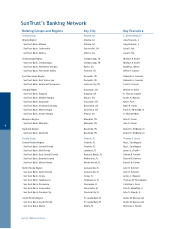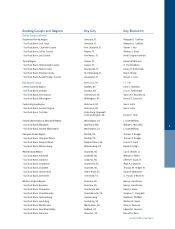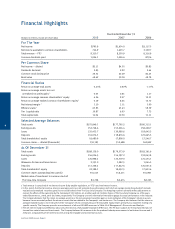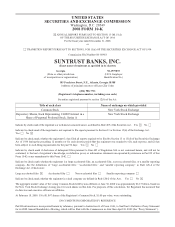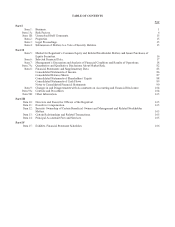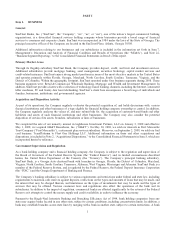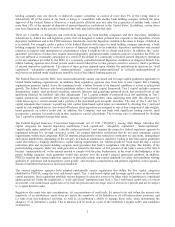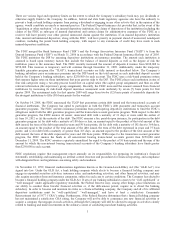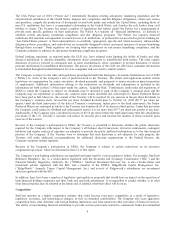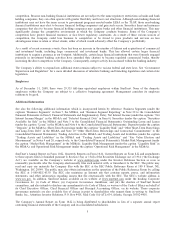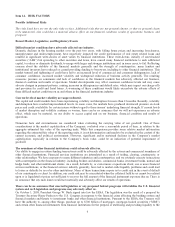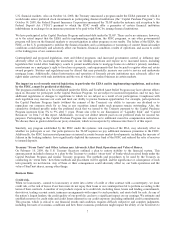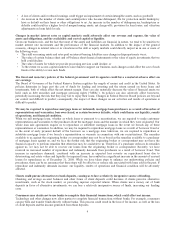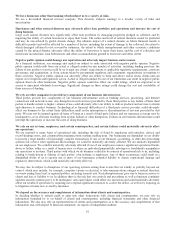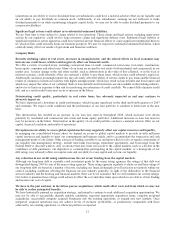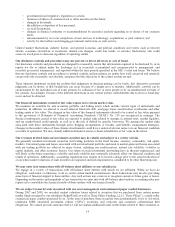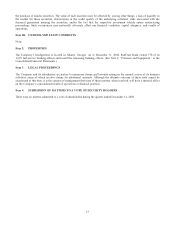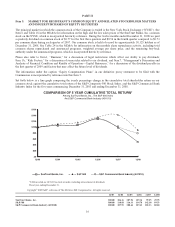SunTrust 2008 Annual Report Download - page 18
Download and view the complete annual report
Please find page 18 of the 2008 SunTrust annual report below. You can navigate through the pages in the report by either clicking on the pages listed below, or by using the keyword search tool below to find specific information within the annual report.Item 1A. RISK FACTORS
Possible Additional Risks
The risks listed here are not the only risks we face. Additional risks that are not presently known, or that we presently deem
to be immaterial, also could have a material adverse effect on our financial condition, results of operations, business, and
prospects.
Recent Market, Legislative, and Regulatory Events
Difficult market conditions have adversely affected our industry.
Dramatic declines in the housing market over the past two years, with falling home prices and increasing foreclosures,
unemployment and under-employment, have negatively impacted the credit performance of real estate related loans and
resulted in significant write-downs of asset values by financial institutions. These write-downs, initially of asset-backed
securities (“ABS”) but spreading to other securities and loans, have caused many financial institutions to seek additional
capital, to reduce or eliminate dividends, to merge with larger and stronger institutions and, in some cases, to fail. Reflecting
concern about the stability of the financial markets generally and the strength of counterparties, many lenders and
institutional investors have reduced or ceased providing funding to borrowers, including to other financial institutions. This
market turmoil and tightening of credit have led to an increased level of commercial and consumer delinquencies, lack of
consumer confidence, increased market volatility and widespread reduction of business activity generally. The resulting
economic pressure on consumers and lack of confidence in the financial markets has adversely affected our business,
financial condition and results of operations. Market developments may affect consumer confidence levels and may cause
adverse changes in payment patterns, causing increases in delinquencies and default rates, which may impact our charge-offs
and provision for credit and fraud losses. A worsening of these conditions would likely exacerbate the adverse effects of
these difficult market conditions on us and others in the financial institutions industry.
Current levels of market volatility are unprecedented.
The capital and credit markets have been experiencing volatility and disruption for more than 12 months. Recently, volatility
and disruption have reached unprecedented levels. In some cases, the markets have produced downward pressure on stock
prices and credit availability for certain issuers without regard to those issuers’ underlying financial strength. If current levels
of market disruption and volatility continue or worsen, there can be no assurance that we will not experience an adverse
effect, which may be material, on our ability to access capital and on our business, financial condition and results of
operations.
Numerous facts and circumstances are considered when evaluating the carrying value of our goodwill. One of those
considerations is the market capitalization of the Company, evaluated over a reasonable period of time, in relation to the
aggregate estimated fair value of the reporting units. While this comparison provides some relative market information
regarding the estimated fair value of the reporting units, it is not determinative and needs to be evaluated in the context of the
current economic and political environment. However, significant and/or sustained declines in the Company’s market
capitalization, especially in relation to the Company’s book value, could be an indication of potential impairment of
goodwill.
The soundness of other financial institutions could adversely affect us.
Our ability to engage in routine funding transactions could be adversely affected by the actions and commercial soundness of
other financial institutions. Financial services institutions are interrelated as a result of trading, clearing, counterparty, or
other relationships. We have exposure to many different industries and counterparties, and we routinely execute transactions
with counterparties in the financial industry, including brokers and dealers, commercial banks, investment banks, mutual and
hedge funds, and other institutional clients. As a result, defaults by, or even rumors or questions about, one or more financial
services institutions, or the financial services industry generally, have led to market-wide liquidity problems and could lead
to losses or defaults by us or by other institutions. Many of these transactions expose us to credit risk in the event of default
of our counterparty or client. In addition, our credit risk may be exacerbated when the collateral held by us cannot be realized
upon or is liquidated at prices not sufficient to recover the full amount of the financial instrument exposure due us. There is
no assurance that any such losses would not materially and adversely affect our results of operations.
There can be no assurance that enacted legislation or any proposed federal programs will stabilize the U.S. financial
system and such legislation and programs may adversely affect us.
On October 3, 2008, President George W. Bush signed into law the EESA. The legislation was the result of a proposal by
Treasury Secretary Henry Paulson to the U.S. Congress in response to the financial crises affecting the banking system and
financial markets and threats to investment banks and other financial institutions. Pursuant to the EESA, the Treasury will
have the authority to, among other things, purchase up to $700 billion of mortgages, mortgage-backed securities (“MBS”)
and certain other financial instruments from financial institutions for the purpose of stabilizing and providing liquidity to the
6


